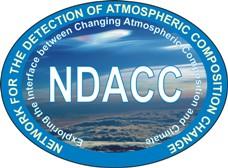Stratospheric Ozone and Ultraviolet Radiation Research
WMO informs about the state of the ozone layer in several ways.
What is ozone?
Ozone is a special form of oxygen with the chemical formula
O3. The oxygen we breathe and that is so vital to life on earth is O2.
Ozone constitutes a very small part of our atmosphere, but its presence is nevertheless vital to human well-being. Most ozone resides high up in the atmosphere, between 10 and 40km above Earth's surface. This region is called the stratosphere and it contains about 90% of all the ozone in the atmosphere.
Why do we care about atmospheric ozone?
Ozone in the stratosphere absorbs some of the Sun’s biologically harmful ultraviolet radiation. Because of this beneficial role, stratospheric ozone is considered “good” ozone. In contrast, excess ozone at Earth’s surface that is formed from pollutants is considered “bad” ozone because it can be harmful to humans, plants, and animals. The ozone that occurs naturally near the surface and in the lower atmosphere is also beneficial because ozone helps remove pollutants from the atmosphere.
Overview and plans of GAW Ozone and UV activities for 2017- 2022
Information on past Ozone and UV activities supported by GAW Programme for the period between 2017 - 2021 and planned activities had been compiled under separate webpage linked here. Its objective is to keep the community informed of different opportunities and to recognize the work of our experts and contributing organizations. Included in the page are short summaries of Quality Assurance and Quality Control activities such as intercomparison campaigns, calibrations; reports from them; new and updated guidelines of observations. Capacity building continues to be in the focus of GAW Programme and took various forms. In this context a page section is dedicated to a description of refresher and training courses; installations of Brewer spectrophotometers donated by the Government of Canada in different parts of the world; refurbishments and reconditioning of Dobson instruments by the Meteorological Observatory Hohenpeissenberg (MOHp) in Germany and their relocation; and new ozonesondes observations. Past and future meetings and important events are also listed with short description of their outcome.
WMO supports new Global Sun-Smart UV App
A new SunSmart Global Ultraviolet Radiation mobile App has been developed by health, radiation and weather experts and is now available globally in Google and Apple App stores. It provides Geo-located 5-day UV and weather forecasts and advises on sun protection times and means along with tailored notifications based on UV levels and weather information. It provides geo-located 5-day UV and weather forecast and sun protection times along with tailored notifications based on UV levels. What makes this App unique is that it offers behavioral prompts to reduce the risks associated with UV exposure based on current UV levels in any location. In an easy to understand language it provides clear guidance as to when sun protection is required and when it is not and how to protect yourself in all official languages of WMO. The applications can also be adapted with the support of country-level weather services to accept data from local UV measuring stations according to the current user location resulting in more accurate current UV Index readings. More information is available on WMO site here.
Videos about atmospheric ozone:
English version: "The ozone hole", Q&A with Geir Braathen, WMO Senior Scientific Officer, Atmospheric Environment Research Division, Research Department.
French Version: "Le trou dans la couche d'ozone" Questions et réponses avec Geir Braathen, Fonctionnaire Scientifique Principal, Bureau de la Recherche Atmosphérique et de l’Environnement, Département de la Recherche, OMM.
Joint WMO/UNEP movie about the ozone layer: Click here.
WMO Bulletins
WMO Ozone Bulletins are temporary suspended. Their format is currently under review. Old issues could be found under the following link. Information on the state of environmental issues in the focus of GAW including current levels and trends of the Ozone Depleting Substances in the atmosphere can be found in the series of WMO Greenhouse Gas Bulletins, Aerosol Bulletins and Air Quality and Climate Bulletin.
GAW Ozone Observing System
The GAW total ozone and profile ozone networks were designated at baseline networks of the Global Climate Observing System (GCOS) in 2007.
An overview of the GAW Ozone Observing System is available here.
Individual components of GAW Ozone Observing System, their roles, interactions and place in the GAW and WMO Observing Systems are described here.
WMO coordinates the global ozone observing network
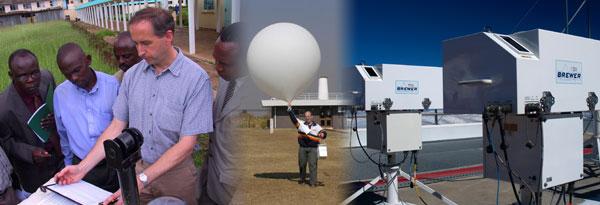
The WMO-GAW ozone observing system comprises more than 100 stations worldwide that measure total column ozone and ozone profiles in the troposphere and stratosphere. The WMO secretariat coordinates training and calibration excercises. The WMO-GAW World Calibration Centre for Dobson total ozone measurements is located at the Global Monitoring Division of NOAA. The WMO-GAW World Calibration Centre for Brewer total ozone measurements is located at Environment Canada. The WMO-GAW World Calibration Centre for ozonesonde measurements is located at Forschungszentrum Jülich, Germany.
Up to date summaries of recent and planned activities related to training, inter-comparison campaigns, workshops, latest Quadrennial Ozone Symposium, reports and other documents on Ozone and UV observations and research are available below and in more details under the link here.
Data from the WMO-GAW ozone observing system are collected and stored at the WMO World Ozone and Ultraviolet Radiation Data Centre (WOUDC) at Environment Canada, Toronto.
The WMO-GAW ozone observing system provides important data for the assessment of the state of the ozone layer and the data are used in the quadrennial WMO/UNEP Scientific Assessment of Ozone Depletion (see below).
Contributing Networks
Several observational networks are contributing to the overall GAW system. In the field of ozone observations these two networks are linked to GAW. Click on them to go to their respective web sites.
Network for the Detection of Atmospheric Composition Change (NDACC) | |
Southern Hemisphere Additional Ozone Sonde Network (SHADOZ) | 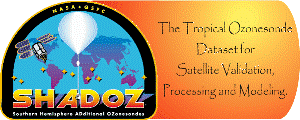
|
Ozone and UV activities in 2022
The XVII Intercomparison Campaign of the Regional Brewer Calibration Center-Europe, Physikalisch-Meteorologisches Observatorium (Davos, Switzerland), 22 to 31 August 2022. Registration form will be available at the RBCC-E web page. Please register before 31st March 2022.
Ozone-related publications
Persistent extreme ultraviolet irradiance in Antarctica despite the ozone recovery onset, R. Cordero et al.
Chile has a station on King George Island on the northern tip of the Antarctic Peninsula since 2016. 2020 ground-based measurements showed that the UV index peaked at 14 in early December. A paper on this issue recently was published in Nature. By analyzing satellite ozone time series and UV times series (measured at Palmer station on the Antarctic Peninsula), authors concluded that, despite the Antarctic ozone recovery observed in early spring, the conditions that favor extreme surface UV events persist in late spring, when the biologically effective UV radiation is more consequential. These conditions include long-lasting ozone holes (attributable to the polar vortex dynamics) that often bring ozone-depleted air over the Antarctic Peninsula in late spring. Another important point is that such extreme surface UV events in late spring are also affecting the Southern tip of South America (~400,000 inhabitants). Unfortunately, there are not quality-controlled ground-based UV measurements in that region… The paper could be accessed through this link. The measurements from 2021 are being analyzed.
Consistency of total column ozone measurements between the Brewer and Dobson spectroradiometers of the LKO Arosa and PMOD/WRC Davos, J. Gröbner et al.
Major improvements in the Dobson - Brewer TOC agreement has been previously demonstrated as part of a comprehensive study by Gröbner et al., 2021 in Arosa and Davos. The presented methods reduced an observed 0.9% variability between the Brewer and Dobson instruments down to 0.1% (monthly means). In their analysis, they applied:
- Rayleigh scattering cross-sections from Bodhaine et al. (1999)
- O3 absorption cross-sections from Serdyuchenko et al. (2014),
- Teff from either ozone-sondes or ECMWF,
- measured line spread functions of Brewer and Dobson.
The link to the paper for more details.
Ozonesonde Measurement Principles and Best Operational Practices, ASOPOS 2.0, 2021 GAW Report #268
Report on the Unexpected Emissions of CFC-11, WMO Library, Ozone Research and Monitoring, 2021 WMO Report #1268
Report from the XIV Regional intercomparison of the Brewer Calibration Center for Europe (RBCC-E) El Arenosillo Atmospheric Sounding Station of the “Instituto Nacional de Técnica Aeroespacial” (INTA) 17 – 28 June 2019 GAW Report 257
Report from the fifth Intercomparison of Dobson Spectophotometers (IC/BUA-19) Main Buenos Aires Observatory (Villa Ortúzar) of the Servicio Meteorológico Nacional (Argentina) (SMN) 4 - 22 March 2019 GAW Report No. 267
Report from the twelfth Intercomparison Campaign of the Regional Brewer Calibration Center Europe El Arenosillo Atmospheric Sounding Station, Huelva, Spain 29 May - 9 June 2017 GAW Report 248
Report from the International Comparison of Dobson Spectrophotometers, Pretoria, Gauteng Province, South Africa 7–18 October 2019, GAW Report 253
7 March 2015: The following research article has been published under the SI2N initiatiave: Intercomparison of vertically resolved merged satellite ozone data sets: interannual variability and long-term trends. Click here to read the article, published in ACP.
Useful links to stratospheric ozone and UV radiation web sites
WMO World Ozone and UV radiation Data Centre (WOUDC)
European Brewer Network – EUBREWNET
Regional Brewer Calibration Center for Europe (RBCC-E)-Iberonesia
World Meteorological Organization (WMO) Dobson Ad-Hoc Committee (DAHC)
World Dobson Calibration Center
World Calibration Center - Ultraviolet
DLR World Data Centre for Remote Sensing of the Atmosphere (WDC-RSAT)
NOAA-NCEP: Meteorological Conditions and Ozone in the Polar Stratosphere
British Antarctic Survey: Jonathan Shanklin's web site with data in near-real time
CNRS, Service d'Aéronomie, Web site with SAOZ data in near-real time
NOAA/ESRL Global Monitoring Division's Home Page (data from South Pole and other stations)
Brewer data from the Argentine station Marambio (maintained by the Czech Hydrometeorological Inst.)
Ground based and satellite data from the University of Bremen
Data from the Microwave Limb Sounder (MLS) on the AURA Satellite
UV data from Dirección Meteorológica de Chile
Data on ozone and UV radiation from the Antarctic Network of NILU-UV radiometers
UV and ozone web site of NIWA with UV Index forecasts
University of Cambridge Ozone Hole Tour
Ozone web page of the Servicio Meteorológico Nacional of Argentina
World Meteorological Organization - United Nations Environment Programme (UNEP) joint work
Meetings of the Ozone Research Managers
Part II of the 11th Meeting of the Ozone Research Managers (Online Meeting) 19-23 July 2021
The World Meteorological Organization, in collaboration with the United Nations Environment Programme (UNEP) arranged the 11th Meeting of the Ozone Research Managers of the Parties to the Vienna Convention for the Protection of the Ozone Layer as Online Meeting from 19-23 July 2021. The report from the Meeting can be found in Ozone Research and Monitoring series as WMO GAW Report No. 271.
The 10th Meeting of the Ozone Research Managers: Geneva 28-30 March 2017
The World Meteorological Organization, in collaboration with the United Nations Environment Programme (UNEP) arranged the 10th Meeting of the Ozone Research Managers of the Parties to the Vienna Convention for the Protection of the Ozone Layer in Geneva from 28 to 30 March 2017. The report from the Meeting can be found in Ozone Report no 57.
The 9th Ozone Research Managers' Meeting: Geneva 14-16 May 2014
The World Meteorological Organization, in collaboration with the United Nations Environment Programme (UNEP) arranged the 9th Meeting of the Ozone Research Managers of the Parties to the Vienna Convention for the Protection of the Ozone Layer in Geneva from 14-16 May 2014. The report from the Meeting can be found in Ozone Report no 54.
The 8th Ozone Research Managers' Meeting: Geneva 2-4 May 2011
The World Meteorological Organization, in collaboration with the United Nations Environment Programme (UNEP) arranged the 8th Meeting of the Ozone Research Managers of the Parties to the Vienna Convention for the Protection of the Ozone Layer in Geneva from 2-4 May 2011. The report from the Meeting can be found in Ozone Report no. 53.
The 7th Ozone Research Managers' Meeting: Geneva 18-21 May 2008
The World Meteorological Organization, in collaboration with the United Nations Environment Programme (UNEP) is arranged the 7th Meeting of the Ozone Research Managers of the Parties to the Vienna Convention for the Protection of the Ozone Layer in Geneva from 18-21 May 2008. The report from the Meeting can be found in Ozone Report no. 51.
The 6th Ozone Research Managers' Meeting: Vienna 19-21 September 2005
The World Meteorological Organization, in collaboration with the United Nations Environment Programme (UNEP) arranged the 6th Meeting of the Ozone Research Managers of the Parties to the Vienna Convention for the Protection of the Ozone Layer in Vienna from 19-21 September 2005. The report from the Meeting can be found in Ozone Report no. 48.
WMO/UNEP Scientific Assessment of Ozone Depletion

| 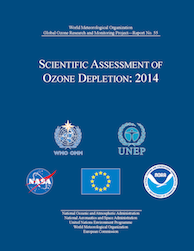
| 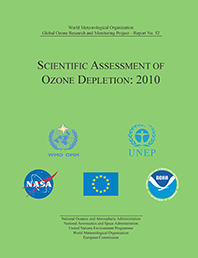
|
2018 | 2014 | 2010 |
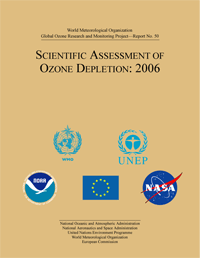
| 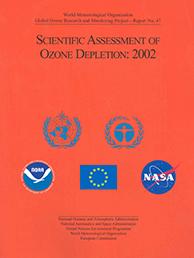
| |
2006 |
More information about the WMO/UNEP Scientific Assessments of Ozone Depletion can be found at the ozone assessment web pages of NOAA.

